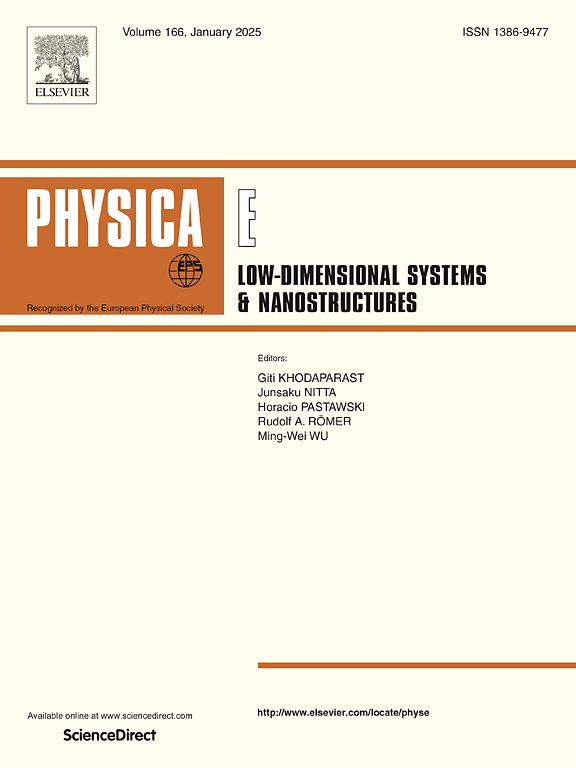Effect of the position of a hydrogen-like impurity on the generation of the third harmonic in a cylindrical quantum dot
IF 2.9
3区 物理与天体物理
Q3 NANOSCIENCE & NANOTECHNOLOGY
Physica E-low-dimensional Systems & Nanostructures
Pub Date : 2025-03-08
DOI:10.1016/j.physe.2025.116223
引用次数: 0
Abstract
This paper presents a theoretical study of the third-order nonlinear optical susceptibility in a GaAs/Ga0.6Al0.4As cylindrical quantum dot (CDQ) with a hydrogen-like impurity inside. The variational method was utilized to calculate the energies and wave functions corresponding to the bound states of the impurity, which include the -like, -like, -like, and -like states, with consideration of the impurity’s motion within the cylindrical quantum dot. The findings indicate that the resonant peaks of the optical third harmonic generation (THG) coefficient undergo a red shift as the impurity is displaced from the center of the CDQ towards the potential barrier. This shift can be attributed to a reduction in the average electrostatic interaction between the impurity and the surrounding ion as the impurity approaches the potential barrier. This phenomenon can be attributed to the decreased electrostatic attraction between the impurity and the quantum dot core as the impurity moves away from the center and approaches the region of higher potential confinement. These findings have significant implications for the design and optimization of quantum dot-based optoelectronic devices, as manipulation of the impurity position can provide additional control over the nonlinear optical properties of these systems.

类氢杂质的位置对圆柱形量子点三次谐波产生的影响
本文对含有类氢杂质的GaAs/Ga0.6Al0.4As圆柱量子点(CDQ)的三阶非线性光学磁化率进行了理论研究。考虑杂质在圆柱形量子点内的运动,利用变分方法计算了杂质束缚态(1s-like、2p -like、2p+ like和2pz-like)对应的能量和波函数。结果表明,当杂质从CDQ中心向势垒移动时,光学三次谐波产生(THG)系数的共振峰发生了红移。这种转变可以归因于杂质和周围离子之间的平均静电相互作用的减少,因为杂质接近势垒。这种现象可以归因于杂质和量子点核心之间的静电吸引力减少,因为杂质远离中心并接近高电位限制区域。这些发现对基于量子点的光电器件的设计和优化具有重要意义,因为对杂质位置的操纵可以提供对这些系统非线性光学特性的额外控制。
本文章由计算机程序翻译,如有差异,请以英文原文为准。
求助全文
约1分钟内获得全文
求助全文
来源期刊
CiteScore
7.30
自引率
6.10%
发文量
356
审稿时长
65 days
期刊介绍:
Physica E: Low-dimensional systems and nanostructures contains papers and invited review articles on the fundamental and applied aspects of physics in low-dimensional electron systems, in semiconductor heterostructures, oxide interfaces, quantum wells and superlattices, quantum wires and dots, novel quantum states of matter such as topological insulators, and Weyl semimetals.
Both theoretical and experimental contributions are invited. Topics suitable for publication in this journal include spin related phenomena, optical and transport properties, many-body effects, integer and fractional quantum Hall effects, quantum spin Hall effect, single electron effects and devices, Majorana fermions, and other novel phenomena.
Keywords:
• topological insulators/superconductors, majorana fermions, Wyel semimetals;
• quantum and neuromorphic computing/quantum information physics and devices based on low dimensional systems;
• layered superconductivity, low dimensional systems with superconducting proximity effect;
• 2D materials such as transition metal dichalcogenides;
• oxide heterostructures including ZnO, SrTiO3 etc;
• carbon nanostructures (graphene, carbon nanotubes, diamond NV center, etc.)
• quantum wells and superlattices;
• quantum Hall effect, quantum spin Hall effect, quantum anomalous Hall effect;
• optical- and phonons-related phenomena;
• magnetic-semiconductor structures;
• charge/spin-, magnon-, skyrmion-, Cooper pair- and majorana fermion- transport and tunneling;
• ultra-fast nonlinear optical phenomena;
• novel devices and applications (such as high performance sensor, solar cell, etc);
• novel growth and fabrication techniques for nanostructures

 求助内容:
求助内容: 应助结果提醒方式:
应助结果提醒方式:


